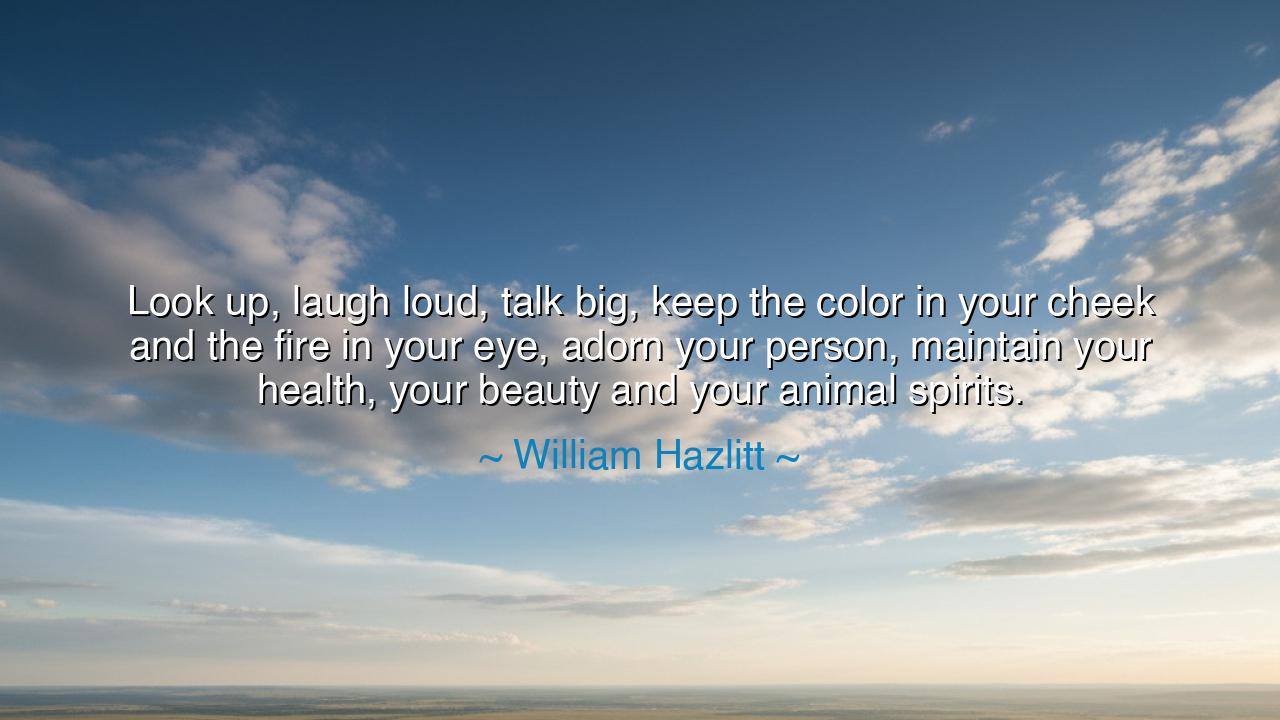
Look up, laugh loud, talk big, keep the color in your cheek and
Look up, laugh loud, talk big, keep the color in your cheek and the fire in your eye, adorn your person, maintain your health, your beauty and your animal spirits.






In the spirited words of William Hazlitt, the great essayist and lover of life, we find a commandment for the soul: “Look up, laugh loud, talk big, keep the color in your cheek and the fire in your eye, adorn your person, maintain your health, your beauty and your animal spirits.” These are not the empty phrases of a man of leisure—they are a call to vitality, a declaration that to live well is itself an act of courage. Hazlitt speaks as one who knew both the heights of inspiration and the depths of melancholy, and yet refused to bow before despair. In his words, he urges us to live not timidly, but abundantly, to carry ourselves as beings worthy of existence.
The origin of this wisdom lies in the romantic spirit of the 19th century, an age when men and women wrestled with passion, intellect, and the dawn of the modern world. Hazlitt, ever the philosopher of feeling, believed that the greatest tragedy was not death, but the slow death of enthusiasm. Thus, he exhorted humanity to keep the color in the cheek and the fire in the eye—symbols of joy, courage, and presence. For he knew that when vitality fades, so too does purpose. To look up is to face the heavens with hope. To laugh loud is to proclaim defiance against sorrow. To talk big is to dream beyond fear.
In every age, there have been souls who embodied Hazlitt’s creed. Think of Theodore Roosevelt, who, though frail and sickly as a boy, refused to surrender to weakness. Through sheer will and devotion to life’s vigor, he transformed himself into a man of boundless energy and strength—a statesman, explorer, and lover of nature. He lived with color in his cheeks and the wild light of conviction in his eyes. Roosevelt once said, “Do what you can, with what you have, where you are,” echoing the same flame that burned in Hazlitt’s heart: the belief that health, courage, and enthusiasm are not gifts bestowed, but powers cultivated.
Hazlitt’s command to “adorn your person” is not vanity, but reverence. To care for one’s appearance, to move with dignity, and to present oneself with grace is not arrogance—it is the outward reflection of inward harmony. The ancients too believed this. The Greeks spoke of kalokagathia, the union of beauty and goodness, for they saw that the well-kept body was the mirror of a disciplined spirit. Thus, when Hazlitt tells us to maintain our beauty, he speaks of far more than the face; he means the wholeness of character that shines through the eyes, the voice, and the bearing of the soul.
And what of “animal spirits”? This phrase, so full of ancient vigor, reminds us of our primal connection to the pulse of life. It is the energy that drives the heart to beat, the blood to surge, and the will to act. In an age where many move through life half-awake, Hazlitt’s words strike like a trumpet in the dawn: do not grow dull, do not drift into apathy. Run, sing, strive, breathe deeply—honor the body that carries you through the world. For the spirit that neglects its vessel cannot soar, and the body that forgets its joy becomes a prison.
Hazlitt’s message is not only a celebration of vitality—it is a protest against despair. Life, he reminds us, is not meant to be endured, but embraced. Even in times of hardship, we can lift our heads, breathe in the light, and meet the day with laughter and strength. To live fully is to rebel against the shadows that seek to quiet our hearts. It is to answer sorrow with song, to defy time with passion, and to greet the world not as a victim, but as a participant in the great dance of existence.
So let his words become a daily vow: Look up when the world would have you bow. Laugh loud when fear whispers silence. Talk big when doubt makes you small. Keep your color, your fire, your health, and your beauty as sacred trusts. For these are the signs of a life truly lived. Tend to your body, nurture your spirit, and wear your joy as armor.
The lesson is clear and enduring: the gift of life is not in how long it lasts, but in how brightly it burns. To live well is to live vividly—to keep the flame alive through courage, laughter, and care. As Hazlitt teaches, vitality is not youth—it is the timeless art of living awake. And when the day comes that your voice joins the chorus of those who have gone before, may it be said that you, too, kept the color in your cheek and the fire in your eye until the very end.






AAdministratorAdministrator
Welcome, honored guests. Please leave a comment, we will respond soon